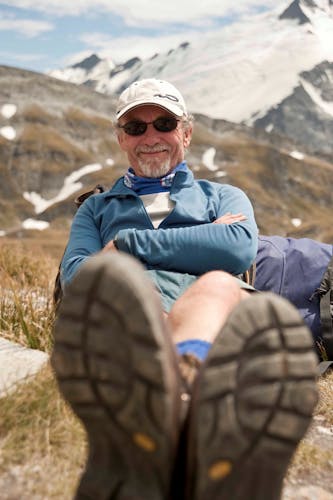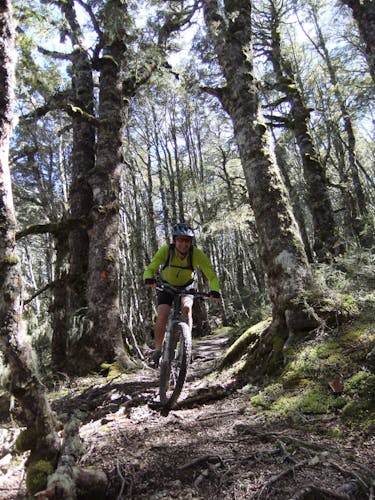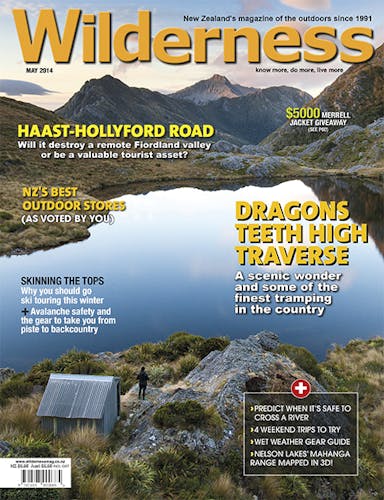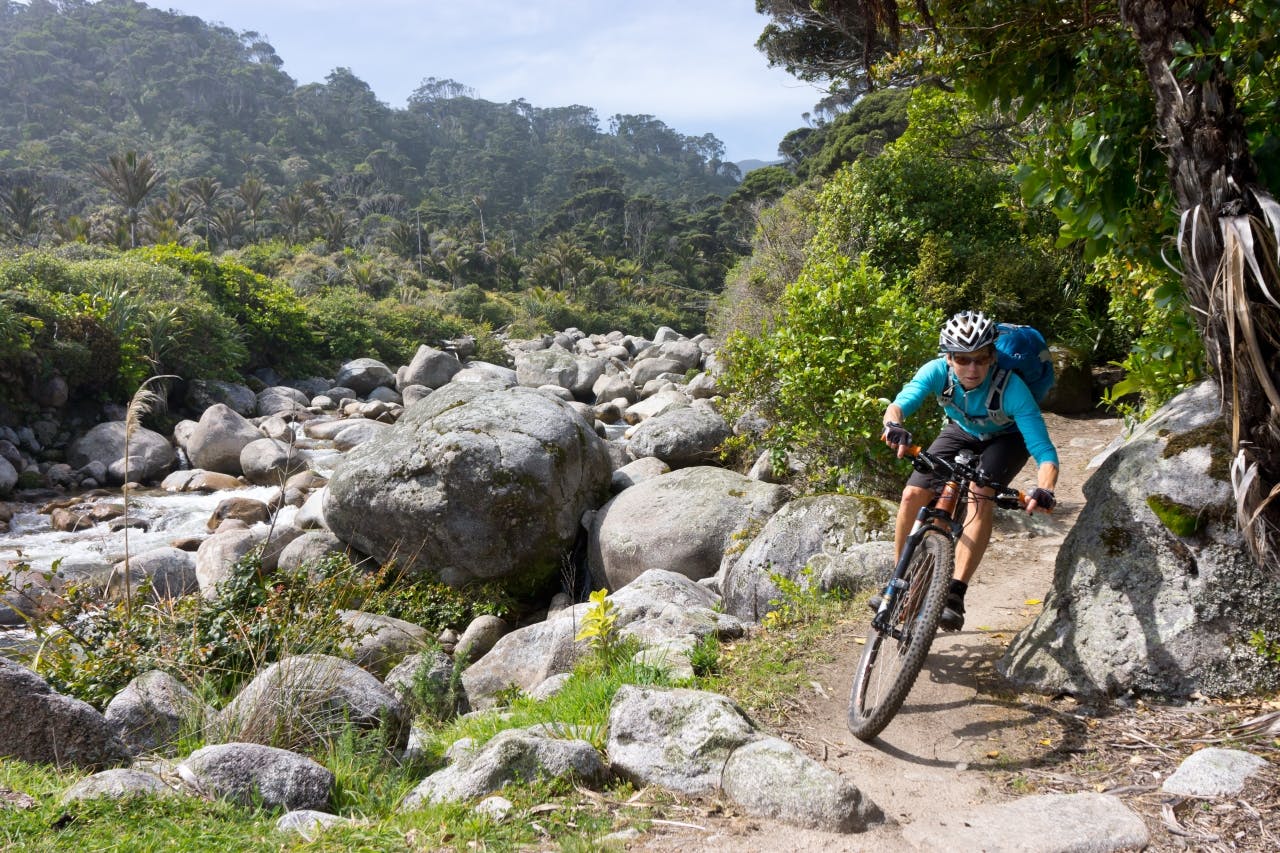After the apparent success of allowing shared tramper-biker use on the Heaphy Track, attention is now on whether the likes of the Kepler and Abel Tasman Coast Track should become dual use. By Matthew Pike
Last winter I walked the Heaphy Track. I knew bikes would be present and, to start with, I was apprehensive. The track’s an easy grade and every time I approached a corner I expected to be barged into a bush by a sudden high-speed burst of dirt and spandex. I had visions of being left lying with a skewed hat, black eye and having been sprayed with mud from head to toe.

Andy Dennis is opposed to expanding mountain biking on tramping tracks, saying nature should be enjoyed at its own pace
Photo: Shaun Barnett
This never happened, of course, and I actually spent the next few days befriending numerous wheel-happy folk. We shared anecdotes, jokes and tea bags in much the same way two groups of trampers would. At no stage were there raised voices or vein-throbbed foreheads.
It’s fair to say DOC’s three-year trial to allow mountain bikers to share the Heaphy Track with trampers was, by and large, a success. Not everyone agrees and some believe the decision to make it permanent was already made before the trial began.
But even its sternest critics would have to admit that the three-year test went without major hitch in regards to tramper-biker confrontation. Of the 144 feedback responses about biker and tramper experiences during the trial, just six were negative. The trial also helped to fill what would otherwise have been almost empty huts, with nearly 6000 bikers using the track over the trial period.
The Heaphy’s not the only track now shared with bikers – the Flora Saddle to Barron Flat and the Kill Devil tracks, also in Kahurangi National Park, have been subject to similar trials and are now permanent year-round dual use tracks. The Queen Charlotte Track in Marlborough and the Moerangi Track in Te Urewera are more examples of tramping tracks that are now dual use. The Queen Charlotte has, in fact, just been widened by 30cm to further accommodate both forms of travel.
And not one of these tracks has seen an instance of tramper-biker confrontation serious enough to be reported to DOC HQ. In fact, in the case of the Heaphy, the discussion is now about whether to extend the biking season, rather than scrap it.
So is this an inevitable trend that trampers will have to get used to? Does the apparent success of these ventures mean we’ll be sharing more of our favourite tracks in future?
DOC is currently gauging public reaction to the idea of opening part of the Kepler Track to bikers in its conservation management strategy for Southland. It doesn’t clarify how much of the track it’s referring to, but the section from the control gates to Brod Bay Shelter seems the most likely.
“With the Kepler Track, people typically water taxi past the first section, so you have a hardened good flat track with not many walkers,” says Karyn Owen from Venture Southland, which has commissioned research into the potential to extend the cycle network in the region.
At the moment, Fiordland National Park’s Management Plan outlaws the use of bikes on formed tracks within the park and any decision to make the Kepler dual use would require a revised plan. This is why, Owen says, DOC is keen to test the water.
“A plan change would be costly,” she says. “So they’re now listening to how the public feel about it. DOC is open to the idea – they’ve seen the research carried out on the Heaphy Track and nothing terribly bad seemed to happen there.
“We’ve seen more people on bikes in the region and research seems to indicate it’s a growth area. So DOC has put together a list of potentials to start the discussion.”
It’s the type of discussion we may see more of in the future, according to Martin Rodd, of DOC Motueka, who was instrumental in managing the Heaphy trials. But he says the department will be very careful before making any major decisions in this field.

Guy-Wyn Williams: Trail Fund NZ’s Guy Wynn-Williams supports the development dual-use trails
“I definitely think we’ll see the number of mountain bike applications raised in National Park Management Plans around the country,” says Rodd. “Whether or not they’re approved is a different story. You have to think of the ability of the park to handle it. In Rakiura, for instance, the nature of the ground means, I think, you would be quicker walking! I can’t see it happening there.
“But there are more opportunities in Kahurangi National Park beyond those we’ve created so far. And there’s interest in potentially making parts of Abel Tasman Coast Track and Inland Track open for mountain bikers.”
Ask any bike-based business and they’ll tell you the sport has taken off in the last 15 years. Queenstown and Rotorua have both harnessed the craze, but usually by creating new tracks or by developing tracks that were already multi-use. They’ve steered clear from asking trampers and walkers to share paths they previously called their own.
But bike enthusiasts have noticed a sea change in DOC’s attitude to this practice and the suggestion of making parts of the Kepler dual use even took them by surprise.
“It was a surprise to us, but when we looked at it we realised it wasn’t a silly question to ask,” says Guy Wynn-Williams of Trail Fund NZ, a group that supports and develops bike-accessible trails.
“That section of track’s not used very much in winter, it’s dry and well constructed. The surprise has been with the shift from the battle we encountered in the old days, to working with us in a common sense way.
“It’s accepted now that mountain biking is a bona fide outdoor activity, whereas 10 years ago we had to keep making that point.”
Wynn-Williams says many of the concerns about sharing tracks are perceptions rather than reality. “The Heaphy is a classic example because many were concerned it would accelerate damage to the track and there’s an abundance of evidence to show this is not the case. There were also concerns that trampers would get hit or spooked by bikes – this can happen but it’s very seldom.
“Not all tracks are suitable for bikes – many in the backcountry would be silly to ride a bike on – so when we discuss it we always come at the angle that it needs to be sustainable. We need to be seen as responsible.”
The sea change in DOC’s attitude to bikers has been especially noticeable in the Nelson-Tasman region. Gone are the days, says Kaiteriteri Mountain Bike Park manager Guy Trainor, when developing tracks to accommodate bikers in national parks is out of the question.
“They’re now encouraging us to apply for funds to convert certain tramping tracks to dual use,” says Trainor. “Converting to dual use is good for some of the lesser used tramping tracks. And for bikers who want the true backcountry experience there’s often little work that needs to be done.
“I’ve not encountered any conflict. I’ve ridden the Flora Saddle to Barron Flat Track every year for a number of years and have never encountered a single tramper. This was an ideal track to convert to dual usage.
“I’m not surprised at all with the success of the Heaphy. I rode it one September before it was legal to take your bike there and only passed two trampers on the whole track.”
However, Trainor isn’t quite so sure about whether converting the Abel Tasman Coast Track would be such a good idea. “I’ve heard rumours that people would like to see it open to bikers for a weekend in winter, but I see problems with this. It’s a popular walking track and you will get conflict situations. But, if carefully managed, they may be able to do it when walker traffic is at its lowest.”
The idea of dual use tracks is a depressing one for Nelson-based tramper and author Andy Dennis. Dennis believes nature should be enjoyed at its own pace. He can accept mountain biking on the Heaphy Track, though he doesn’t like it, but the Kepler Track is a step too far.
“I don’t think the development of tramping tracks to dual use is a good thing and I’m dead against it happening on the Kepler,” says Dennis.
“I go into the wild to get away from vehicles and I think it’s an important experience to hang on to. There are so many other places in the country where mountain bikers can go and I think we need to defend wilderness qualities by going at a natural pace within our wild places. I don’t think we should be bringing modernity and machines into the wild.”
Dennis believes the Abel Tasman Coast Track can no longer be regarded as a wilderness area, but that allowing bikers along this track would create its own problems.
“The track has around 150,000 people walking it each year and mountain bikes would just make things worse. Of all the tracks, this one would be incompatible with bikers.
“Having said that I think biking is fantastic exercise and I cycle on the Great Taste Trail regularly. I think projects such as the Mt Cook to Oamaru trail (Alps 2 Ocean) are good because it’s through wild country but on tracks vehicles have used in the past.”
So is it possible to continue making dual-use tracks while keeping everybody happy? Is the lack of incident so far beginner’s luck or is there a winning formula?
Martin Rodd, of DOC Motueka, says developments need to be made with great care. “The key thing is to get it right. You need to identify whether it’s sustainable and consult with people.
“Be aware of who the track users are and make sure there are no surprises. Socialise the idea of bikes and work out the track design – it’s good to have people who have worked on bike tracks before to show you where the track needs work.
“Many people worry that bikers will go too fast, but track design can have a great impact on speed.”
With new bike tracks popping up throughout the country, there doesn’t seem to be a major rush to convert those already used by trampers. But if evidence continues to show minimal impact and higher hut usage when mountain bikers are given access, then don’t be surprised if more tracks are added to a list under the heading ‘potentials’ in future.







